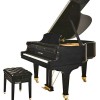
Success in this market enabled them to expand. based company began small with limited capital and benefited from individual attention to detail and limited production. This is where the Mason & Hamlin company began – as an organ manufacturer. As a gifted inventor, he developed a method of voicing organ reeds to imitate the sounds of various other instruments. “…I desire to play the Mason & Hamlin pianos…I feel that if I have succeeded in making even the slightest impression upon the public by my playing, a great part of my success is due to your instruments.”Įmmons Hamlin’s skills were not musical but rather mechanical. His father Lowell Mason was considered the ‘father of American church music’ and was known worldwide as a respected composer and publisher of hymns. His family members were descendants of pilgrims who crossed over to the continent on the Mayflower. Henry Mason was an accomplished pianist and came from a family steeped in American and musical history. The early days of Mason & Hamlin drew upon each of the men’s individual skills. Henry Mason and Emmons Hamlin came from different backgrounds which were of great benefit to their new company. The Founders & Engineers During The Early History Created one year after the founding of Steinway & Sons in 1854, Mason & Hamlin quickly asserted themselves as a company dedicated to handcrafted quality and today is one of only two fully operational piano manufacturers in the United States today (with the other being their longtime competitor, Steinway).


However, it would be very remiss to ignore the contributions and the ongoing history of another leading piano maker, Mason & Hamlin. Steinway has long enjoyed a spot at the top of American piano manufacturers in both artists’ use and public opinion. Now normally, the first name to come to mind when thinking of premium pianos is probably the venerable Steinway & Sons company. From 1854 to Today | Mason & Hamlin The tale of the Mason & Hamlin’s rise to the top of the piano world is an interesting piece of history, dating back to the mid 19 th century.


 0 kommentar(er)
0 kommentar(er)
